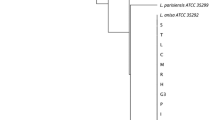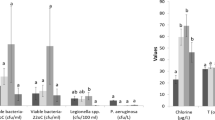Abstract
The main aim of the study was to test for the presence of Legionnaires’ disease-causing microorganisms in air-conditioned buildings in Kuwait using molecular technologies. For this purpose, 547 samples were collected from 38 cooling towers for the analysis of Legionella pneumophila. These samples included those from water (n = 178), air (n = 231), and swabs (n = 138). Out of the 547 samples, 226 (41 %) samples were presumptive positive for L. pneumophila, with L. pneumophila viable counts in the positive water samples ranging from 1 to 88 CFU/ml. Of the Legionella culture-positive samples, 204 isolates were examined by latex agglutination. These isolates were predominately identified as L. pneumophila serogroup (sg) 2–14. Using the Dresden panel of monoclonal antibodies, 74 representatives isolates were further serogrouped. Results showed that 51 % of the isolates belonged to serogroup 7 followed by 1 (18 %) and 3 (18 %). Serogroups 4 (4 %) and 10 (7 %) were isolated at a lower frequency, and two isolates could not be assigned to a serogroup. These results indicate the wide prevalence of L. pneumophila serogroup 7 as the predominant serogroup at the selected sampling sites. Furthermore, the 74 L. pneumophila (sg1 = 13; sg3 = 13; sg4 = 3; sg7 = 38; sg10 = 5; sgX = 2) isolates were genotyped using the seven gene protocol sequence-based typing (SBT) scheme developed by the European Working Group for Legionella Infections (EWGLI). The results show that Legionella isolates were discriminated into nine distinct sequence typing (ST) profiles, five of which were new to the SBT database of EWGLI. Additionally, all of the ST1 serogroup 1 isolates were of the OLDA/Oxford subgroup. These baseline data will form the basis for the development of a Legionella environmental surveillance program and used for future epidemiological investigations.

Similar content being viewed by others
References
Allerberger F (2012) Molecular typing in public health laboratories from an academic indulgence to an infection control imperative. J Prev Med Public Health 45:1–7
Al-Matawah Q, Al-Zenki S, Al-Azemi A, Ben Haji A, Al-Mutairi T (2008) Detection and monitoring of Legionella spp. in Kuwait waters. Kuwait Institute for Scientific Research, Report No. KISR9424, Kuwait
Al-Matawah QA, Al-Zenki SF, Qasem JA, Al-Waalan TE, Ben Haji AH (2012) Detection and quantification of Legionella pneumophila from water systems in Kuwait residential facilities. J Pathogens 5, 138389. doi:10.1155/2012/138389
Al-Terkait N, Sadak A (2006) A travel abroad-associated case of Legionella pneumonia. Kuwait Med J 38:59–60
Amemura-Maekawa J, Kura F, Chang B, Watanabe H (2005) Legionella pneumophila serogroup 1 isolates from cooling towers in Japan form a distinct genetic cluster. Microbiol Immunol 49:1027–1033
AS/NZS 3896 (1998) Waters-examination for Legionellae. Standards Australia, North Sydney, NSW, Australia
Behbehani N, Mahmood A, Mokaddas EM, Bittar Z, Jayakrishnan B, Khadadah M, Pacsa AS, Dhar R, Chugh TD (2005) Significance of atypical pathogens among community-acquired pneumonia adult patients admitted to hospital in Kuwait. Med Prin Pract 14:235–240
Bentham RH (2000) Routine sampling and the control of Legionella spp. in cooling tower water systems. Curr Microbiol 41:271–275
Bonura C, Mammina C, Vella A, Belfiore S, Chiarinin A, Giammanco A (2009) A combined molecular typing approach does not discriminate Legionella pneumophila serogroup 1 strains of a predominant sequence based type in Palermo, Italy. J Infect Public Health 2:184–188
Cazalet C, Jarraud S, Ghavi-Helm Y, Kunst F, Glaser P, Etienne J, Buchrieser C (2008) Multi genome analysis identifies a worldwide distributed epidemic Legionella pneumophila clone that emerged within a highly diverse species. Genome Res 18:431–441
Conseil supérieur d’hygiène publique de France (2005) Le risque lié aux légionelles. Guide d’investigation et d’aide à la gestion. Rapport du Conseil Supérieur d’Hygiène Publique de France Juillet 2005. Rapport du Conseil Supé rieur d’Hygiène Publique de France. http://www.sante.gouv.fr/htm/pointsur/legionellose/guid2005.pdf. Accessed Oct 2010
Doleans A, Aurell H, Reyrolle M, Lina G, Freney J, Vandenesch F, Etienne J, Jaraud S (2004) Clinical and environmental distributions of Legionella strains in France are different. J Clin Microbiol 42:458–460
Faris B, Faris C, Schousboe M, Heath CH (2005) Legionellosis from Legionella pneumophila Serogroup 13. Emerg Infect Dis 11:1405–1409
Gaia V, Fry NK, Harrison TG, Peduzzi R (2003) Sequence-based typing of Legionella pneumophila serogroup 1 offers the potential for true portability in legionellosis outbreak investigation. J Clin Microbiol 41:2932–2939
Gaia V, Fry NK, Afshar B, Lü ck PC, Meugnier H, Etienne J, Peduzzi R, Harrison TG (2005) Consensus sequence-based scheme for epidemiological typing of clinical and environmental isolates of Legionella pneumophila. J Clin Microbiol 43:2047–2052
Garbe LP, Davis JB, Weisfeld JS, Markowitz L, Miner P, Garrity F, Barbaree JM, Reingold AL (1985) Nosocomial legionnaires’ disease: epidemiologic demonstration of cooling towers as a source. JAMA 254:521–524
Grottola A, Forghieri F, Meacci M, Fabio A, Pozzi L, Marchegiano P (2012) Severe pneumonia caused by Legionella pneumophilaserogroup 11, Italy. Emerg Infect Dis 18:1911–1913
Harrison TG, Doshi N, Fry NK, Joseph CA (2007) Comparison of clinical and environmental isolates of Legionella pneumophila obtained in the UK over 19 years. Clin Microbiol Infec 13:78–85
Harrison TG, Afshar B, Doshi N, Fry NK, Lee JV (2009) Distribution of Legionella pneumophila serogroups, monoclonal antibody subgroups and DNA sequence types in recent clinical and environmental isolates from England and Wales (2000–2008). Eur J Clin Microbiol 28:781–791
Helbig JH, Kurtz JB, Pastoris MC, Pelaz C, Luck PC (1997) Antigenic lipopolysaccharide components of Legionella pneumophila recognized by monoclonal antibodies: possibilities and limitations for division of the species into serogroups. J Clin Microbiol 35:2841–2845
Helbig J, Bernander S, CastellaniPastoris M, Etienne J, Gaia V et al (2002) Pan-European study on culture-proven Legionnaires’ disease: distribution of Legionella pneumophila serogroups and monoclonal subgroups. Eur J Clin Microbiol 21:710–716
Kozak NA, Benson RF, Brown E, Alexander NT Jr, Taylor TH, Shelton BG, Fields BS (2009) Distribution of lag-1 alleles and sequence-based types among Legionella pneumophila serogroup 1 clinical and environmental isolates in the United States. J Clin Microbiol 47:2525–2535
Kyung LH, Shim JI, Kim HE, Yu JY, Kang YH (2010) Distribution of Legionella species from environmental water sources of public facilities and genetic diversity of L. pneumophila serogroup 1 in South Korea. Appl Environ Microb 76:6547–6554
MOP (2009) Annual statistical abstract. Central Statistical Bureau, Ministry of Planning, Kuwait
Qasem JA, Mustafa AS, Khan ZU (2008) Legionella in clinical specimens and hospital water supply facilities: molecular detection and genotyping of the isolates. Med Prin Pract 17:49–55
Qasem JA, Al-Khalaf BN, Qasem AA, Ghulam AH, Bidass G (2013) Application of three uniplex polymerase chain reaction assays for the detection of atypical bacteria in asthmatic patients in Kuwait. J Infect Public Health 6:134–141
Ratzow S, Gaia V, Helbig JH, Fry NK, Luck PC (2007) Addition of neuA, the gene encoding Nacylneuraminate cytidylyl transferase, increases the discriminatory ability of the consensus sequence-based scheme for typing Legionella pneumophila serogroup1 strains. J Clin Microbiol 45:1965–1968
Reimer AR, Au S, Schindle S, Bernard KA (2010) Legionella pneumophila monoclonal antibody subgroups and DNA sequence types isolated in Canada between 1981 and 2009: laboratory component of national surveillance. Eur J Clin Microbiol 29:191–205
Rivera JM, Aguilar L, Granizo JJ, Vos-Arenilla A, Gimenez MJ, Aguiar JM, Prieto J (2007) Isolation of Legionella species/serogroups from water cooling systems compared with potable water systems in Spanish healthcare facilities. J Hosp Infect 67:360–366
Tijet N, Tang P, Romilowych M, Duncan C, Ng V, Fisman DN, Jamieson F, Low DE, Guyard C (2010) New endemic Legionella pneumophilaserogroup I clones, Ontario, Canada. Emerg Infect Dis 16:447–454
Yamamoto H, Sugiura M, Kusunoki S, Ezaki T, Ikedo M, Yabuuchi E (1992) Factors stimulating propagation of Legionellae in cooling tower water. Appl Environ Microbiol 58:1394–1397
Yu VL, Plouffe JF, Pastoris MC, Stout JE, Schousboe M, Widmer A, Summersgill J, File T, Heath CM, Patterson DL, Chereshsky A (2002) Distribution of Legionella species and serogroups isolated by culture in patients with sporadic community-acquired legionellosis: an international collaborative survey. J Infect Dis 186:127–128
Acknowledgments
The authors would like to acknowledge the Kuwait Foundation for the Advancement of Sciences (KFAS) and the Kuwait Institute for Scientific Research (KISR) for their kind funding and support for this project.
Author information
Authors and Affiliations
Corresponding author
Additional information
Responsible editor: Philippe Garrigues
Rights and permissions
About this article
Cite this article
Al-Matawah, Q., Al-Zenki, S., Al-Azmi, A. et al. Legionella detection and subgrouping in water air-conditioning cooling tower systems in Kuwait. Environ Sci Pollut Res 22, 10235–10241 (2015). https://doi.org/10.1007/s11356-015-4226-z
Received:
Accepted:
Published:
Issue Date:
DOI: https://doi.org/10.1007/s11356-015-4226-z




